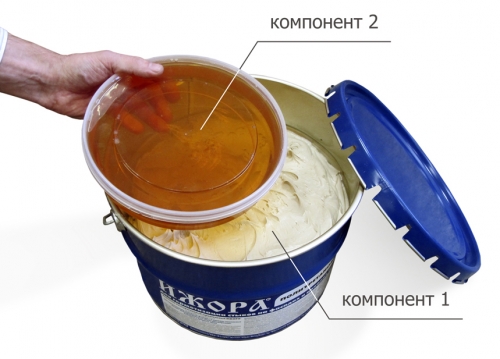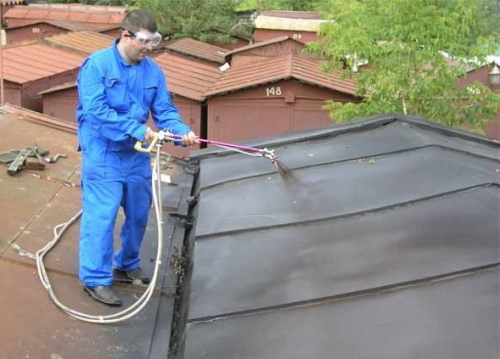Element of the door box, functional design, which is designed for ...
|
|
Choosing roofing materials among a large number of manufacturers ... |
Building facade is an important stage of construction work. The face of the house should ... |
Application of bitumen mastic

Processing of surfaces with bitumen The most affordable and effective method of waterproofing of brick, concrete structures, metal tanks, pipes, beams made of wood and other building materials. However, bitumen in its pure form is inherent in some shortcomings, the material is complicated in application, and under the influence of temperature changes, the protective film is cracking. Substances are added to the composition of modern bituminous mastics that increase the hardness and crack resistance of the waterproofing coating.
Consider the technical and operational properties of bitumen possesses, what technology should be adhered to when applying the material, as well as give recommendations for the choice of waterproofing mastic.
- The composition of the bitumen mastic
- Bitumen mastic: characteristics and properties of the material
- Scope of bitumen mastic
- Classification of waterproofing mastics
- Review of products of leading manufacturers of bitumen mastic
- Bitumen mastic consumption: norms and calculation
- Bitumen mastic
- Bitumen mastic waterproofing technology
- General recommendations for working with bitumen mastic
The composition of the bitumen mastic
Bitumen mastic is plastic material with high astringent and waterproofing properties. In addition to bitumen, the material includes astringent organic substances and mineral -based additives.
Hardness, density and resistance to low temperatures provide the following components:
- asbestos dust;
- mineral wool;
- quartz, limestone and brick powders (dusty) on a thin -leaf basis;
- combined ash.
The presence of functional thickeners (peat crumbs, chalk, ground asbestos) guarantees the convenience of applying mastic, reducing consumption and improves the thermal insulation properties of the material.
For resistance to bends and reinforcement of the material, fibrous fillers of bitumen mastic are responsible. Polymer components give the material waterproofing qualities.
Bitumen mastic: characteristics and properties of the material
The scope of the use of bitumen mastic determines its technical characteristics:
- conditional strength - 0.2-0.5 MPa (kgf/cm2);
- adhesion strength with concrete 0.3-0.4 MPa (kgf/cm2);
- waterjacking during the day by weight not more than 0.5-1%;
- lengthening with a rupture of 100-300% (depending on the type of bitumen mastic);
- conditional viscosity of at least 15-30 seconds;
- the softening temperature is not less than 100-130 ° C.
Technical characteristics of bitumen mastic give the material of the following operational qualities:
- High elasticity. This property provides reliable adhesion of the material with the surface protected from moisture. In addition, elasticity holds the coating from cracking and gaps.

- Adhesive properties. Bitumen mastic can be used as an adhesive component in the arrangement of roll waterproofing.
- Protection of various building structures from moisture.
- The use of bitumen mastic prevents the appearance of foci of corrosion.
- Increasing the life of buildings elements. In this case, the functionality of the structure is fully preserved.
- Resistance to temperature fluctuations is especially relevant when arranging waterproofing in regions with a harsh climate.
- The hardened bitumen film is stained in any color.
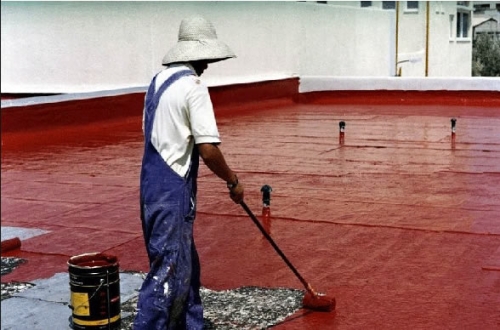
Scope of bitumen mastic
Waterproofing mastics have a wide area of \u200b\u200bapplication. Most often, bitumen materials are used to perform the following works:
- arrangement of a new roof;
- carrying out the repair of the old roof: alignment of the concrete base, removal on the roller layer of waterproofing with depressions, with a depth of about 5 mm;
- waterproofing of artificial reservoirs, pools, fountains;

- use when installing tile coating in places with a high level of humidity;
- processing of metal products as anti -corrosion protection;
- waterproofing of roof adjustments to parapets, ventilation/smoke ducts and drain pipes;
- foundation protection;
- installation of roll waterproofing (bitumen mastic acts as adhesive);
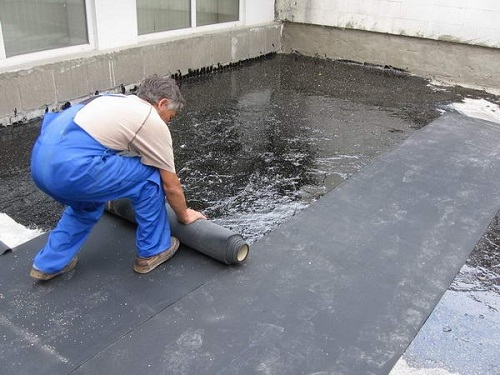
- installation of heat -insulating plates on bitumen mastic;
- the arrangement of waterproofing in rooms with insufficient ventilation and excess moisture (bathrooms, pools, saunas, basements, loggias and garages).
Important! The use of bitumen mastic is relevant for various types of roofs: metal rocky, roll, slate, from reinforced concrete plates, etc.
Bitumen mastic: use for roof repair
Classification of waterproofing mastics
All bitumen mastics can be classified according to three main criteria:
- application method;
- method of preparation;
- type of elastic additives.
Depending on the technological features of application, two types of mastics are distinguished: hot and cold application.
Mastic hot use Before use, it is necessary to warm up to 150-300C. This significantly complicates the process of waterproofing of the surface. The advantages of hot mastics include:
- the formation of a particularly durable coating with a high degree of elasticity;
- the protective film does not give shrinkage;
- the possibility of work at negative air temperatures;
- incorrect structure of the material;
- available cost.
Hot bitumen mastics are used to strengthen the base and create reliable protection of the foundation in difficult conditions
Cold mastics are more popular in use. This is due to a number of advantages of the material:
- the simplicity of application is not necessary to warm up mastic;
- wide color scheme of bitumen waterproofing;
- stability to ultraviolet radiation.
Cold masticsmixed with a solvent, after the evaporation of which, the coating hardens and acquires the necessary operational characteristics
According to the method of preparation, bitumen mastics are divided into two types:
- one -component;
- two -component.
One -component compositions They can be used immediately after opening the container, do not require additional preparation. However, such material has a significant drawback after opening, it is necessary to develop the entire bank, otherwise the mastic will harden. This quality must be taken into account when carrying out work on a large surface.
Two -component compositionsbefore work, you need to mix with the thickener. Preparation does not take much time, but the shelf life of such mastics is much more than one -component bitumen.
Depending on the type of elastic additives that make up the bitumen mastic, such types of waterproofing materials are distinguished:
- Rubber mastic. The material is based on oxidized oil bitumen, mineral fillers, rubber crumb of a small fraction, synthetic rubber and solvents. Creates a solid coup with almost any material, including open metal. Rubber mastic is not afraid of sprains, shots and has a wide range of operating temperatures (from -40C to +100C).

- Bitumen-teddy mastic (BKM) is a record holder for elasticity. The protective film formed after applying bitumen mastic can increase the initial length by 20 times. At the same time, the gaps are not formed. The scope of BKM is gluing linoleum, roofing material, parquet and plywood. In addition, mastic is used as anti -corrosion protection of metal products, pipelines and concrete structures.
- Bitumen-polymer masticit is made from a water emulsion of bitumen and modified by latex. The material does not contain organic solvents, so it can be used both outside of the premises and inside. After solidification, a vapor barrier and waterproof film is formed, which has good adhesion with wood, steel, concrete and brick.

Review of products of leading manufacturers of bitumen mastic
The production of bitumen mastic is engaged in both domestic and foreign companies. Consider the most popular brands.
Mastic waterproof It has such characteristics:
- rupture for stretching 37-60 kgf;
- flexibility and absolute water resistance;
- withstands an increase in temperature to +85C for 2 hours;
- the life of the coating is 15 years;
Technonikol company Developed a whole line of bitumen mastics and materials for preparing the base:
- For waterproofing the foundation, roof and deepened structures are used:
- mastic Bitumen Roof Technomast No. 21;
- Medn Mastic waterproofing No. 24;
- water -based mastic No. 33;
- hot mastic of Eureka No. 41;
- bitumen-resin mastic No. 20.
- To carry out waterproofing work, indoors of the premises use the Bitumen mastic of Technonikol No. 31 Water emulsion of oil bitumen.
- To protect the coating from UV radiation and thermal abrasion, aluminum mastic No. 57 is used. The composition of the material includes an aluminum pigment with reflective properties.
Russian rastro company releases waterproofing materials under two brands:
- Izhora - bitumen -polymer sealants and hot mastics.
- Slavyanka is a cold bitumen -polymer mastic designed for waterproofing roofs, foundations and culverts.
In addition, companies are in good demand: Bitumast and Remers Elastoplast.
Bitumen mastic consumption: norms and calculation
Mastics consumption is usually indicated on the label. If this parameter is not specified, then it can be calculated independently, focusing on the following recommendations:
- The consumption of the material directly depends on the percentage composition of volatile solvents. Usually this indicator ranges from 20-70%. With a 70% indicator, mastic consumption will be 3 times less than at 20%.
- When calculating, it is important to take into account the consumption standards for performing different works:
- waterproofing of the foundation 2-4 kg/ m2;
- roof arrangement 3.5-6 kg/m2;
- gluing roofing material 1-2 kg/m2.
Important! When processing vertical surfaces, the mastic is applied in two layers. Cover the second layer only after the previous
Bitumen mastic
Based on the considered classification, we can conclude that there are two main ways to apply bitumen mastic: cold and hot. In addition, cold mastic can be applied both manually and mechanically.
Manual methodit implies the use of large painting hands having a short and hard bristle. For such work, flute brushes are best suited. Mastic can be applied with a short -term seating roller.
When waterproofing horizontal surfaces, the emulsion is poured onto the base, neatly levels the rocket, and then rubbed with a roller or brush.
Mechanized methodit implies the use of an airless sprayer with a working pressure of 150 bar. The unit should be specially designed for viscous trains.
Important! Only sprayers are suitable for work in which mixing components occurs inside
Bitumen mastic waterproofing technology
Here is a step -by -step course of work on the waterproofing of the roof with bitumen mastic of cold use:
- In accordance with the instructions, add the solvent to the composition of the mastic and mix thoroughly.
- Before using roofing mastic, it is advisable to warm in the room for 24 hours at a temperature of more than +15C.
- Remove garbage, deformation coating, clean snow and ice from the surface to be treated.
- The base of the roof is treated with a bitumen primer. It is not worth neglecting this step, especially if the mastic is applied to the porous surface.

- Dry the coverage area. Some mastics can also be treated with wet surfaces (the corresponding mark should be on the label of the container with emulsion).
- Pour a little mastic onto the roof, smooth the mop and grind on the surface with a brush.

- In places of conjugation and adjacency, where cracks are possible and coating waterproofing must be reinforced in the places of location of cold seams:
- fiberglass material (fiberglass or fiberglass) drown in the first layer of mastic (overlaps on both sides of the problematic place should be at least 10 cm);
- roll the surface of the material with a roller;
- after the first layer of mastic dries, apply a second layer of coating waterproofing over reinforcement.
Advice! Before applying mastic, a test must be carried out and the degree of moisture in the base must be determined. To do this, put a plastic film with a size of 1*1 m on the prepared surface of concrete. If condensation does not appear under the film after 4-24 hours, then you can proceed to processing the base with mastic
General recommendations for working with bitumen mastic
- Work on applying coating waterproofing should be carried out in dry weather, at an air temperature of at least -5C.
- Vertical surfaces are processed in two layers. The consumption of mastic for each layer is 0.5-0.7 kg/m2.
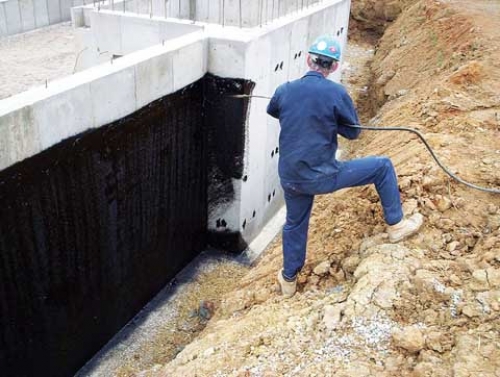
- It is necessary to store bitumen mastic in a closed container, away from sources of fire and direct sunlight.
- The mastic is applied in the direction from the bottom-up parallel stripes of uniform thickness. The layer should be continuous and without breaks.
- For a better stirring of mastic, you can use a drill with a surround-up.
- You can apply a bitumen primer with an ordinary painting brush, since the material has a lighter consistency.
- At the end of the work, it is necessary to immediately rinse all the tools using white spirit or solvent.







